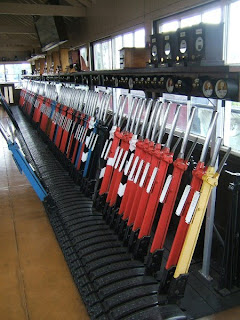I've been interested in railway signalling from a fairly tender age. 'Visiting Signalboxes' talks about this interest and links to recollections of a number of signalboxes. Railway Signalling is a massive subject and I can't hope to offer a comprehensive guide but I will attempt to outline some of the principles involved in a (no doubt erratic) series of articles. This series is confined to 'Britain'. British methods were exported to many parts of the world (particularly former British Empire countries) but quite different techniques evolved elsewhere.

Early railways used hand signals to communicate with trains. On the Stockton and Darlington Railway, it's said that at night they placed a candle in the window if they wanted a train to stop. The problems of correctly interpreting such casual indications led to the creation of 'fixed signals'. This is a post, fixed in a given location, on which some sort of signal can be displayed, to provide a more effective method of signalling to trains. Different railways initially used an amazing variety of Fixed Signals with Disks, Square boards, Crossbars, Balls, Arms, even a 'Curtain' in a frame which could be displayed or furled away. These 'targets' could be raised, lowered, twisted on edge, pivoted or even taken away.

A crucial shortcoming of the early hand signals was that whilst various displays with arms raised were given to signal 'Caution' or 'Stop', 'All Right' was usually given by standing at 'Attention' with arms lowered. In other words, if you couldn't see arms, that meant 'All Right'. At first, fixed signals has the same weakness. For instance, a vertically-pivoted disc could be twisted on edge to be invisible to the approaching train. Thus, if a driver couldn't see a signal, he assumed it was 'All Right'.
Gradually, signals evolved into the form we recognise with a flat blade or arm extending from the post and pivotted to it, rather like the mechanical semaphores then used for telegraph purposes. The word 'semaphore' is also used to describe this class of railway signals.
But the idea of 'hiding' the arm for 'All Right' persisted in designs where the arm could be lowered until it hung down vertically in a slot in the signal post.

The idea that a signal should always give a positive indication was not fully adopted until after the Abbots Ripton accident in 1876 where a signalman attempted to place signals at 'Danger' but, with previously-lowered arms frozen in the slot, 'All Clear' continued to be displayed (There's an excellent Wikipedia article describing this accident).
Double-track railways
Back in 1830, the Liverpool & Manchester Railway adopted a 'Time Interval' system, suitable for a double-track railway where trains were only allowed to travel in one direction on each line. In Britain, double-track railways, like roads, adopted left-hand running. There were initially no 'fixed signals' but 'Railway Policeman', stationed at strategic places along the railway, would give different hand signals to an approaching train, according to the time which had elapsed since the previous train had passed. The 'Time Interval' system was a fairly rough-and-ready approach which failed to ensure that trains maintained a safe separation.
It was eventually realised that a 'Space Interval' system was required. The invention of the Electric Telegraph allowed the Block System to be developed. The 'Railway Policeman' became the 'Signalman' (although railway slang still refers to a signalman as 'Bobby' for the same reason that civil police may be called 'Bobbies' - in commemoration of the creation of the Police Force by Sir Robert Peel).
Each signalman became responsible for the line on which trains approach extending from the previous signalman to his own location. This was called the 'Block Section'. Each signalman communicated with the signalmen on either side using special electric telegraph instruments called 'Block Signalling Instruments'. There's a post with more information on the Block Signalling Instruments used by the London and North Western Railway here.
Single-track railways
Single-line railways needed a different approach as there was not only the danger of one train catching up with another but the possibility of two trains meeting head-on. Single-line control eventually benefitted from the use of electricity allowing communication from one end of a single line section to the other.
Go to Part 2 - Semaphore Signals.
Sunday, 28 April 2013
Railway Signalling in Britain: Part 1: Introduction
Subscribe to:
Comments (Atom)
